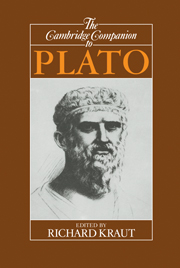Book contents
- Frontmatter
- 1 Introduction to the study of Plato
- 2 Plato
- 3 Stylometry and chronology
- 4 Socrates and the early dialogues
- 5 Mathematical method and philosophical truth
- 6 Inquiry in the Meno
- 7 Plato and Greek religion
- 8 Platonic love
- 9 Plato's metaphysical epistemology
- 10 The defense of justice in Plato's Republic
- 11 Plato on poetic creativity
- 12 Good-bye to the Third Man
- 13 Plato's Sophist on false statements
- 14 Disintegration and restoration
- 15 Plato's later political thought
- Bibliography
- Index
5 - Mathematical method and philosophical truth
Published online by Cambridge University Press: 28 May 2006
- Frontmatter
- 1 Introduction to the study of Plato
- 2 Plato
- 3 Stylometry and chronology
- 4 Socrates and the early dialogues
- 5 Mathematical method and philosophical truth
- 6 Inquiry in the Meno
- 7 Plato and Greek religion
- 8 Platonic love
- 9 Plato's metaphysical epistemology
- 10 The defense of justice in Plato's Republic
- 11 Plato on poetic creativity
- 12 Good-bye to the Third Man
- 13 Plato's Sophist on false statements
- 14 Disintegration and restoration
- 15 Plato's later political thought
- Bibliography
- Index
Summary
PLATO'S ACADEMY AND THE SCIENCES
At some time between the early 380s and the middle 360s Plato founded what came to be known as the Academy. Our information about the early Academy is very scant. We know that Plato was the leader (scholarch) of the Academy until his death and that his nephew Speusippus succeeded him in this position. We know that young people came from around the Greek world to be at the Academy and that the most famous of such people, Aristotle, stayed there for approximately twenty years. However, it appears that, at least in Plato's time, there were no fees attached to being at the Academy. Thus it does not seem likely that it had any official “professorial staff” or that “students” took a set of courses to qualify them to fill certain positions in life. The Academy was more likely a community of self-supporting intellectuals gathered around Plato and pursuing a variety of interests ranging from the abstractions of metaphysics to more concrete issues of politics and ethics.
In Book VII of the Republic Socrates describes a plan of higher education designed to turn the most promising young people of a Utopian city-state into ideal rulers. It is frequently assumed (and quite naturally) that this curriculum bears a significant relation to Plato's plans for the Academy; sometimes it has even been described as essentially the plans themselves. It is important to see that this assumption is subject to major qualifications. For, first of all, fourth-century Athens is not even an approximation to Plato's Utopia; Plato could not expect entrants in the Academy to have been honed in the way the Utopian citizens are supposed to be.
- Type
- Chapter
- Information
- The Cambridge Companion to Plato , pp. 170 - 199Publisher: Cambridge University PressPrint publication year: 1992
- 16
- Cited by

